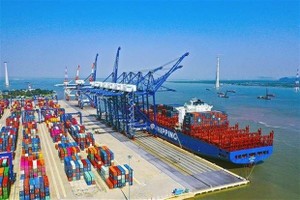 |
Nonetheless, despite the development speed of E-commerce within the country and the increase in cross-border digital services, the revenue increase has been rather insignificant
According to the white paper on E-commerce in 2019, B2C (Business-to-Consumer) retail sales reached US$0.08 bln, accounting for 4.9 percent of total retail sales of consumer goods and digital services nationwide. But according to the latest statistics of the Ministry of Industry and Trade, by the end of 2022, the scale of the retail E-commerce market in Vietnam had reached US$16.4 bln, accounting for 7.5 percent of the sale of consumer goods and digital services across the country. With a growth rate of 20 percent per year, Vietnam is ranked by eMarketer in the group of five countries with the leading E-commerce growth rate in the world.
A growing young population is certainly one driving force that has made E-commerce grow so fast in Vietnam. In addition to a young population who adapt quickly to changes in the digital environment, the main cause of the E-commerce boom in the last few years can be attributed to the Covid-19 pandemic. In 2021, Vietnam was affected by the Covid-19 pandemic and during the lockdown and restrictions period, economic growth was only 2.38 percent. However, E-commerce still maintained a stable growth rate of 16 percent and reached US$13.7 bln in value.
It is not just E-commerce platforms that are thriving, many people are also promoting their businesses on social media platforms such as YouTube, Facebook, or TikTok. The YouTube platform alone has brought in revenue from tens of billions of dongs per year for YouTubers. Along with the business boom through E-commerce and social networks, digital services in Vietnam have also experienced strong growth in recent years.
The Vietnam Digital Marketing Report of 2022 estimates that revenue from online advertising in 2022 in Vietnam reached more than US$1.37 bln, up by 19 percent compared to 2021. Most of this revenue goes to cross-border platforms such as Facebook, Google, and Microsoft, while domestic enterprises only account for a small part of this growing E-commerce business.
The Covid-19 pandemic was instrumental in the speedy adaptation of the E-commerce media in Vietnam, which is continuing to become more and more popular by the day. In 2021, when people were compelled to stay at home due to strict restrictions, then online advertising platforms became immensely active and raked in a lot of money. The rapid development of E-commerce as well as digital services has been a positive sign for the market. Although the revenue is high, the amount of tax being paid is of much concern right now. There was a time when rapidly evolving technology had caused tax budgets to fluctuate greatly.
Tax still low
On 21 March 2022, the General Department of Taxation announced the electronic portal for foreign suppliers. By the end of 2022, there were 42 major foreign suppliers from across the world who registered on it and also declared and paid taxes directly through the website of the General Department of Taxation. The total tax amount of declared taxes was around VND3,444 bln. In this, some foreign suppliers declared and paid a large amount of tax such as Meta (Facebook), Google, TikTok, and Microsoft.
However, even though this tax amount collected may sound like a lot at first, compared to online advertising revenue of US$1.37 bln in 2022, this amount is still insignificant. However, before when there was no portal for foreign suppliers, the incoming revenue was certainly much lower.
Currently, tax amounts coming in from foreign suppliers as well as tax collection from individuals and organizations doing business on E-commerce platforms are getting the attention of the tax department. Data from the E-commerce portal at the end of 2022 shows that there were 14,875 domestic organizations and eight organizations from abroad registered to sell in Vietnam.
The tax industry has information on more than 53,200 domestic individuals and four foreign businesses on E-commerce platforms. More than 14.5 million transactions with a total value of VND4,500 bln took place on this platform. According to the tax department, from 2018 up until now, the amount of money collected by tax authorities from Vietnamese organizations and individuals from income from E-commerce activities and digital services is more than VND1,150 bln. This number has been increasing gradually and rapidly over the years. In 2021, the tax revenue reached VND261 bln and in 2022 this figure increased to more than VND600 bln.
In 2022 alone the E-commerce market was valued at US$16.4 bln but the tax recovery of VND600 bln was too low. Speaking to Saigon Investment, Mr. Đinh Trong Thinh, an economist at the Academy of Finance, said that the tax revenue is increasing year by year, and especially in 2022 the tax department gradually began to tighten tax management for E-commerce activities in general. But in reality, there are still many difficulties because this is a new field for the tax authorities. Mr. Ho Duc Phoc, Minister of Finance, has admitted very frankly to the fact that the tax department is losing a lot of revenue from E-commerce and technology businesses.
In recent years, many individuals and organizations have raised a lot of revenue from Google and YouTube but often overlook paying taxes. Often tax arrears numbers startle people as in the first six months of 2022, the tax department in Ho Chi Minh City tackled 38 people who had generated income from Google and had pending arrears of up to VND169 bln. In this, one individual was charged VND31 bln. The oversight in paying taxes by many organizations and individuals for E-commerce businesses and digital content has caused inequality among business models. In the coming years, the tax department will have to work hard to keep pace with the development speed of E-commerce and digital services in Vietnam.
























